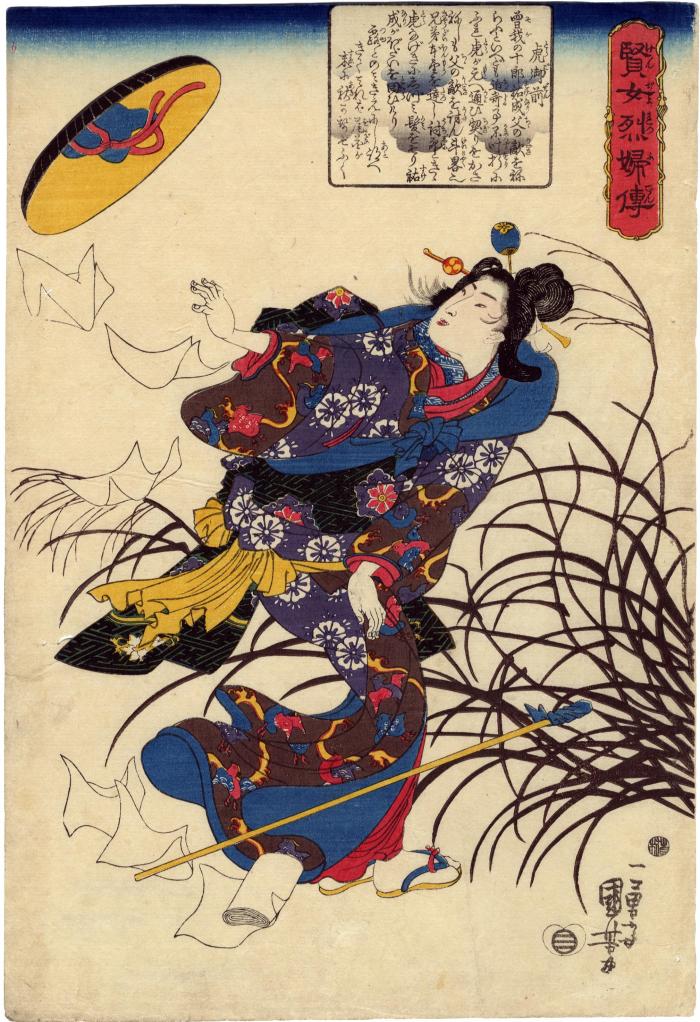Utagawa Kuniyoshi (歌川国芳) (artist 11/15/1797 – 03/05/1861)
Tora-gozen (寅御前) from the series Biographies of Wise Women and Virtuous Wives (Kenjo reppu den 賢女烈婦傳)
ca 1842 – 1843
10 in x 14.5 in (Overall dimensions) Japanese woodblock print
Signed: Ichiyūsai Kuniyoshi ga
一勇斎国芳画
Publisher: Ibaya Senzaburō
(Marks 127 seal 08-067)
Censor's seal: Yoshimura
British Museum
Museum of Fine Arts, Boston
Tokyo Metropolitan Library
Rijksmuseum
Minneapolis Institute of Art - painting of Tora-goza with her lover Jūrō ca. 1710
National Museums of Scotland
The National Museum of Japanese History
Chazen Museum of Art Tora-gozen is one of the figures from the 12th century story of revenge of the Soga brothers. She was the courtesan lover of the older brother, Soga no Jūrō, who was killed in the attack on Suketsune. Legends grew up about her beauty, her devotion and her grief.
****
"...Jūrō had fallen deeply in love with a beautiful courtesan called Ōiso Tora. Realizing he could offer her no future and that he would never see her again once starting on his quest to avenge his father, he wanted to spend some time with her. While Jūrō was visiting the inn where she worked, a large company arrived. It was Lord Yoshimori, his sons and retainers, all loyal to Suketsune. They immediately requested the company of the popular Tora at their banquet, but she was reluctant to leave Jūrō. Finally Kobayashi Asahina, the son of Yoshimori, diplomatically persuaded both to join the group. While they were sitting with the company, Yoshimori asked Tora to present a cup of sake to the man she loved, convinced he was the lucky one. This caused even more problems, as now she had to choose between presenting the cup to her beloved Jūrō and enduring the inevitable wrath of Yoshimori if she spurned him.
At this dramatic juncture Gorō [the younger brother] arrived. He felt his brother was in imminent danger and wanted to rush into the room. The wise Asahina tried to restrain him by pulling the tassels of his armour. They pushed and pulled for a while, both equally strong and resolute, until the tassels broke. Asahina eventually managed to calm Gorō.
Finally, the time had come for the ultimate revenge. The Soga brothers had to announce this officially to Suketsune, as their deeds would then be recognized as vengeance and not as a crime. Asahina, retainer of Suketsune, but also their secret ally, arranged that both were invited for the official New Year celebrations. Many people would attend and all could hear the legitimate announcement.
On the appointed day, Suketsune's palace was festooned with New Year decorations of pine, bamboo and plums. The auditorium was already full of vassals and retainers in their best clothes. The Soga brothers first met Asahina, who had to announce their entrance. They were also dressed in their finest costumes. Before arriving at the residence, Jūrō had warned Gorō to do nothing impetuous.
Suketsune was sitting on a dais at one end of the hall, clad in a black kimono with gold plum-blossom crests. He was not only flanked by his retainers, but also by the two most sought-after courtesans of the day, Ōiso Tora and Kewaizaka Shōshō. Tora was, as we know, the mistress of Jūrō, and Shōshō was the lover of Gorō. As they had been requested to attend the festivities in their professional capacities, they could not refuse. Suketsune had recently been promoted to the Senior Minister of State and Marshal of the Shogun's Hunt, thus obtaining two of the most coveted posts. He was enjoying the situation thoroughly and was flattered by all."
Quoted from: Heroes of the Kabuki Stage by Arendie and Henk Herwig, p. 86.
****
"The heroine of this tale, a young woman named Tora-gozen, becomes a nun after the death of her lover Jūrō, one of the Soga brothers. Later, after having visited his grave, she meets a courtesan who was close to the brothers, Shōshō of Tegoshi, and the two women become nuns at Zenkōji, before joining Hōnen's community."
Quoted from: The Power of Denial: Buddhism, Purity, and Gender by Bernard Faure, p. 220.
****
In Tōkaidō Texts and Tales: Tōkaidō gojūsan tsui by Kuniyoshi, Hiroshige, and Kunisada, edited by Andreas Marks, University Press of Florida, 2015, page 54, it says: "D.E. Mills cites research by Yanagita Kunio on gravestones throughout Japan marked with the name of Tora or Tora-gozen, along with Yanagita's conclusion that such stones mark the graves of women who were a type of itinerant miko, practitioners of religious rites, called tora. The Tora-gozen in the story of the Soga brothers is associated with various religious sites known to be closely connected to their tale, such as the Hakone Shrine. Furthermore, she is linked to the Kumano shrines. Mills proposes that the Kumano bikuni (nuns) played a major role in the development and propagation of the legend of the Soga brothers, and argues that the purpose of the tale was to propitiate their angry spirits and avert any calamities that their spirits might bring down."
****
The inscription reads: 虎御前 曽我の十郎祐成父の#をねらふといへども近寄事不叶折にふれ虎が元へ通ひ契りをかさねしも父の#を討ん計略也 兄弟本望を達し討死ときゝ虎なげきにしづみ髪をそり祐成がぼだいを#ひけり 露とのみまえにし跡へきてみれば尾花が末に秋かぜぞふく
mitate-e (見立て絵) (genre)
Ibaya Senzaburō (伊場屋仙三郎) (publisher)
Soga brothers (曾我兄弟) (genre)
